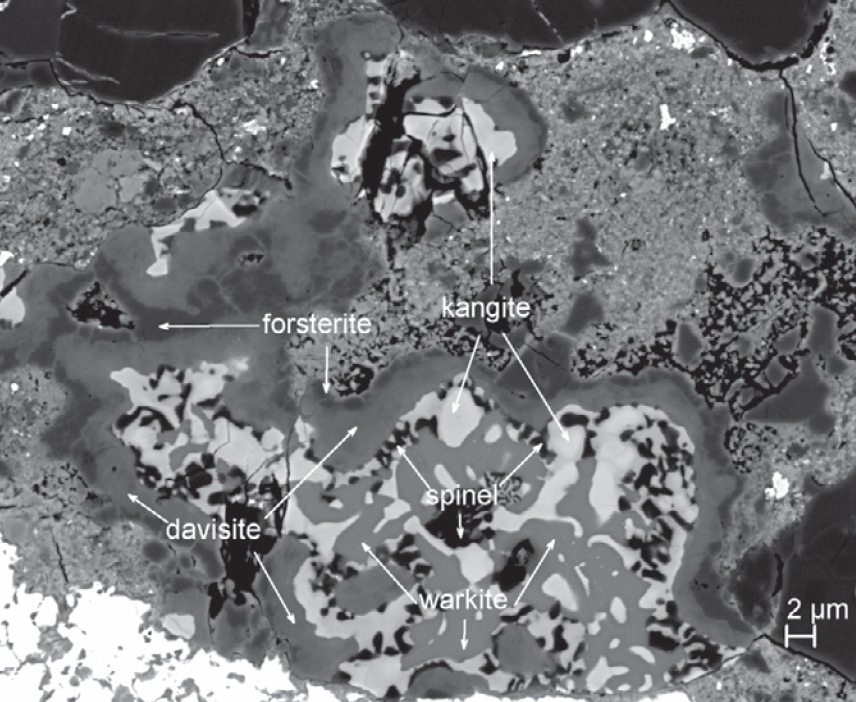Warkite,
Ca2Sc6Al6O20,
a new
mineral in carbonaceous chondrites
and a key-stone
phase in
ultra-refractory inclusions
from the solar nebula
Chi Ma1, Alexander N. Krot2, John R. Beckett1, Kazuhide Nagashima2,
Oliver Tschauner3, George
R. Rossman1, Steven B Simon4, Addi Bischoff5
1 Division of Geological
and Planetary
Sciences 2
Hawai'i
Institute of Geophysics and Planetology
California
Institute of
Technology
University of Hawai'i at Manoa
Pasadena,
CA 91125-2500, USA
Honolulu, Hawai'i, 96822, USA
3 Department of
Geoscience
4Department of Geophysical Sciences
University
of Nevada
University of Chicago
Las
Vegas, Nevada, 89154, USA
Chicago,
Illinois, 60637, USA
5Institut
für Planetologie
Wilhelm-Klemm-Str. 10
48149 Münster, Germany
ABSTRACT
Warkite (IMA
2013-129)
is a new Sc-rich
ultra-refractory mineral in
the rhönite group of the
sapphirine supergroup. It has a P[bar]1
aenigmatite-type structure with a
= 10.367 Å, b = 10.756 Å, c = 8.895
Å, α = 106°, β = 96°, γ = 125°, and Z
= 2, and general
formula of
Ca2(Sc,Ti,Al,Mg,Zr)6Al6O20.
Warkite occurs
as micrometer-sized crystals in
eleven
ultra-refractory Ca,Al-rich inclusions (UR CAIs) from the CM, CV, CO, and
CH chondrites.
In the CM, CO, and CV CAIs, warkite in the cores coexists with a
Ti-rich oxide,
either perovskite or
kangite; the cores are generally mantled and rimmed by davisite and/or
Sc-diopside. In the CH CAIs and one CO CAI, warkite in
the cores coexists
with perovskite and grossite; the cores are mantled by grossite ±
gehlenite,
and rimmed by low-Sc, Al-diopside. Therefore, there
are two basic families of
warkite-bearing inclusions, those containing Sc-rich clinopyroxenes but
no
grossite and those containing grossite but no Sc-rich clinopyroxene. Scandian
clinopyroxene in warkite-bearing CAIs generally formed by the reaction
of
warkite, which supplied most or all of the Sc, Ti, Al, and Ca, and a
nebular
gas that supplied Mg and SiO. The presence of Sc-rich clinopyroxenes
may
reflect exposure of some warkite-bearing CAIs to a dust-rich
environment, which
would enhance partial pressures of Si-, Mg-, and Ca-bearing species in
the
vapor and make it oxidizing relative to a dust-poor gas. Warkite in
grossite-bearing inclusions is
generally Ti3+-enriched relative to those in
davisite-bearing
inclusions, consistent with their formation in relatively dust-poor
environments. Warkite compositions are sensitive to the
presence or
absence of spinel, melilite, Sc-rich clinopyroxenes, and grossite.
Warkite is
an aluminate but often contains measurable Si content, which implies
that this
phase can potentially be used to constrain PSiO
in nebular environments, even if no silicates were present. Compositional
variations of perovskite and warkite grains indicate a connection but,
except
for late-stage Fe exchange, they did not equilibrate with each other.
The
presence of at least two trends in Y-Sc among perovskites without
corresponding
trends in warkite suggests that at least some perovskite formed
separately.
Warkite-bearing
CAIs from CM2s
and CO3.0s are uniformly 16O-rich
(D17O
~ -23‰),
whereas those from metamorphosed COs and CVs are isotopically
heterogeneous: warkite, kangite, perovskite, melilite, and davisite are
16O-depleted
to various degrees (D17O
range from -22
to -2‰)
relative to hibonite, spinel, and
forsterite, all having 16O-rich compositions (D17O
~ -25
to -20‰).
We infer that warkite-bearing CAIs originated in an 16O-rich
nebular gas. Subsequently, CAIs from metamorphosed CVs and COs
experienced O-isotope
exchange with an 16O-depleted external
reservoir, most likely aqueous
fluids on the CV and CO chondrite parent asteroids; however, O-isotope
exchange
in the solar nebula cannot be excluded.

Backscattered
electron image of warkite and other phases in an inclusion in carbonaceous
chondrite meteorite DOM 08006 from the Dominion Range,
Antarctica/

